Students Fees Protest - Day 2
London. Tuesday 30 Nov 2010
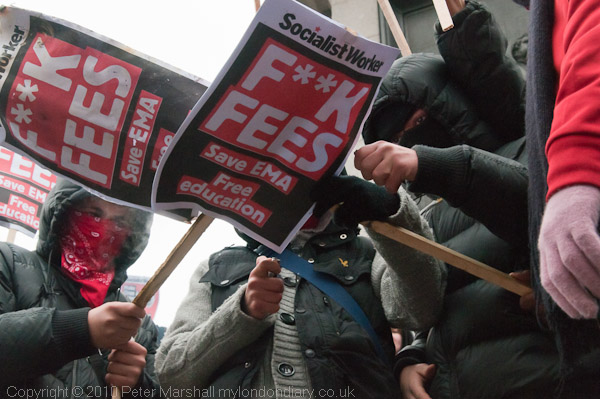
A student holds a lighter to a placard, setting it alight.
more pictures
Around 5000 students took part in a confusing but largely peaceful demonstration
in London against proposed large increases in tuition fees and education cuts.
Students met at Trafalgar Square, where organisers had urged them to begin
with a rally before a peaceful march down Whitehall to a further peaceful
rally in Parliament Square.
When I arrived shortly before the event was due to start there was a crowd
of over a thousand on the east side of Nelson's plinth and in the east side
of the square with much noisy chanting against the cuts, the government and
Nick Clegg in particular. Students are particularly enraged at the actions
of the Lib-Dems, who before the election signed a pledge promising to end
tuition fees. Although some leading Lib-Dems have backed the government proposals
it seems increasinly likely that the party as a whole will abstain when the
vote comes, with possibly some members voting against it.
Although I had expected a number people to speak at the start of the event
in Trafalgar Square there was no sign of this, other than a brief rap over
a megaphone from the ground below the plinth.
The plinth itself was crowded, and people - mainly youths, some of whom told
me they were from South London - were setting light to placards and starting
small fires, the heat from which was very welcome on such a cold day.
The police at this point were standing well back, almost all outside the
centre of the square and taking no part in what was happening. More people
were arriving at the square and numbers grew to several thousands.
The organisers had planned - and apparently agreed with police - for there
to be a march down Whitehall at 1pm, but at around 12.05 there was a call
from some on the plinth to go down and demonstrate at Downing St, and it was
taken up by the crowd. People began to jump down from the plinth and move
across to the top of Whitehall. Then several hundred broke into a slow run
down the middle of the street, and I followed them. There were only a few
police at the top of Whitehall, and their attempts to stop the protesters
were ill-judged as they were completely ineffectual.
Police then formed a line the whole way across the street ahead of them blocking
it, and the protesters began shouting that they were being "kettled"
- as they had been the previous week. By now the people back at the top of
Whitehall were waving frantically for everyone to come back, and most of the
marchers then made their way through Admiralty Arch and on to the Mall before
continuing down Horse Guards Road. As they did so around 50 police came running
through the Horseguards archway from Whitehall and fanned out across the parade
ground to line the side of the demonstration. It was a sight right out of
a silent film. They made no attempt to stop the protesters who continued,
crossing into Storey's Gate, then turning up into Parliament Square.
By this point I think everyone had forgotten that this was the intended destination
of the march. The protesters were obsessed by the idea that the police were
intending to kettle them, and here it did rather look this way, since as they
reached the strong line of police behind barriers in front of Parliament,
the police started to form a line behind them, and there were police blocking
the other exits from the square. The students turned and walked and ran back
the way that had come. Police stopped a few of them, but soon had to give
up as there were too few of them and the rest of the protesters and press
simply walked through. After a brief turn into Storery's Gate the protesters
saw more police ahead and again turned on their heels and headed up Tothill
St.
It was the start of a long rather rapid walk around London by the group of
a thousand or two that I was with, passing close to several likely targets
such as the Lib-Dem HQ and Scotland Yard but not making any attempt to reach
them or demonstrate outside them. It was a lengthy (and for me, still suffering
from a foot injury, painful) tour of London, taking in Hyde Park Corner, Piccadilly
Circus, Oxford Circus and Oxford Street and turning down Kingsway at Holborn
and then walking into the City of London along Fleet St. The marchers were
accompanied by a couple of hundred police who most of the time simply walked
along the sides of the march, but were serving no really useful purpose.
Most of the Met police abandoned the march at the city boundary, with just
a handful continuing with the main group of marchers (by this time it was
down to less than half its original number as others gave up or got lost)
as they their way past St Pauls, the Stock Exchange, on up some of the narrow
winding streets around St Bartholomews Hospital (it rather looked as if they
were trying to kettle themselves there) to Smithfield Market before going
back along Holborn Viaduct where I eventually left them to catch a bus and
make my way back to see what was happening in Trafalgar Square.
At one point in Holborn one of the police medics clearly lost his temper
and lashed out at an unfortunate student who I think had simply got in his
was as the officer tried to push past. I saw one flare being let off as the
marchers were going along Regent St, and a banger was thrown and exploded
at my feet in Holborn. A few students scraped snow from the roofs of passing
cars and threw snowballs at the police and other marchers.
The City of London police appeared to completely ignore the march as it passed
through their area, at least for the first 30 minutes it was in the City,
though as I waited for my bus, 3 vans full of police sped past in the direction
of the march. It seemed to be a very effective tactic as it was almost entirely
trouble free.
By the time I got back to Trafalgar Square all of the exit roads had its
cordon of police standing in front of a small block of police vans. They were
however letting people pass through them in both directions, and the protest
was being isolated and watched rather than being kettled.
Not a lot was happening when I arrived in the square, and some people had
already gone home, but shortly afterwards a largish group - including those
I had been marching with earlier - arrived and things began to get noisy again.
There were a few short speeches, and one of the organisers spoke to say that
the official part of the demonstration was over, thanking people for coming
and asking for their support at a further demonstration on the day of the
vote.
He told those listening that the police had said that they were free to leave
in small groups by the Charing Cross exit if they wished, or that they could
continue to demonstrate, and that the police would probably be prepared to
facilitate a further march if requested. Most of those present seemed to want
to stay and protest, and some called for another attempt to march down Whitehall
without any discussion with the police.
It didn't happen, and I was beginning to think it was time to leave when
there was a commotion a few yards away from where I was standing. A small
group of police had come into the square and had been surrounded by an angry
group and had to make their way back to the nearest police line, across the
top of Cockspur St. Around a thousand students surged after them, and there
was a short period with some scuffles with the police who quickly donned their
riot helmets.
While some students were trying to push through the police, a couple of yards
away other students were linking arms in front of the police to protect them
and stop any violence. Then a group of young women brought up a banner and
stood facing the police, which stopped further pushing in that area.
By now the snow was falling fairly steadily and it was getting dark. It seemed
to me that things were drawing to an end and I walked out of Trafalgar Square
through the line of police who were allowing everyone through in both directions
to Charing Cross station.
After I and most of the protesters had gone home, those remaining in Trafalgar
Square were kettled and a number of arrests were made.
Students Protest Fees & Cuts
Malet St to Whitehall, London. Wed 24 Nov
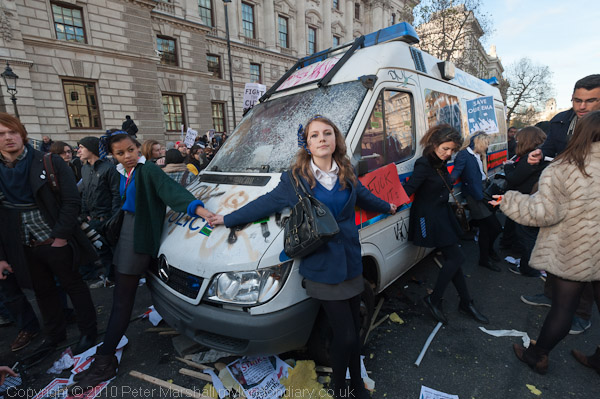
Schoolgirls join hands in an attempt to protect a (possibly deliberately)
abandoned police van from rioters
more pictures
Students marched through London today in a national walkout and day of protest
called by the National Campaign Against Fees and Cuts and Revolution
against tuition fees and education cuts. They planned to march from the University
of London Union in Malet St through Whitehall and then on to the Lib-Dem HQ
in Cowley St. Police stopped them at the end of Parliament Street and held
several thousand in Whitehall for up to 9 or 10 hours.
Similar events as a part of this national day of action were held in most
other major cities in the country as well as at individual schools, colleges
and universities.
Students are incensed at the Browne Review of Higher Education Funding, which
has advocated an increase in tuition fees, allowing them to rise to £9000
a year - £27,000 for a three year course. Living costs are also still
increasing, and a typical student needs around £6000 for the college
year, more in high cost areas such as London. It's also getting harder for
them to find work to support themselves either during the term or between
terms, and those without rich parents need another thousand or two to live
on then.
Add this up, and a three year course can end up costing £50000, a very
heavy commitment for 18 year-olds to face. Putting the Browne proposals into
effect make university a place for the very rich, and also for those minority
of the very poor who manage to struggle through our educational system and
still qualify for some financial assistance.
The Government's spending review calls for the Educational Maintenance Allowances
(EMA) to be scrapped. At the moment it's restricted to 16-18 year-olds in
full time education from a household with an income of less than £30,810
- and the full amount of £30 a week only goes to those whose household
income is less than
£20,817.
The Con-Dem coalition are also removing their funding for university arts
and humanities courses, with 35 percent cut backs to courses which will destroy
some departments. Allowing universities to charge variable fees will lead
to competition between them and to the trimming of they services they give
to students. As always in competitions, some will win and others will lose
and we may well see whole universities go out of business.
Around a thousand students gathered outside the University of London Union
in Malet Street for a march to Whitehall which started around 11.45pm. More
joined in on the way, including a group from the LSE, outside which the whole
march broke into a run and swung round into Aldwich south side where it was
stopped by a row of police vans and officers. Although this was the obvious
route towards Trafalgar Square, the police would not let them continue along
it.
After waiting a few minutes, the crowd surged down towards Temple station
and then resumed normal marching, going along the Embankment and then up a
side street and on the the Strand.
On reaching Trafalgar Square, the march turned down Whitehall and went past
Downing Street. Outside the Treasury it met several thousand other protesters
who had met at noon in Trafalgar Square. They had made their way down Whitehall
and had been stopped by police in Parliament Street, just before the junction
with Parliament Square.
There were now perhaps 5000 students milling around in a small area, some
chanting slogans (rather than the rather ordinary ones about education and
cuts many favoured "Tory Scum, Here we come" and a long drawn out
"David Camero-o-on, answered by the crowd with "F**k off back to
Eton") but most just standing around waiting for something to happen.
People had expected to march further on, to the Lib-Dem headquarters in Cowley
St, and also for there to be a rally, but neither seemed likely to happen.
Some musicians had been expected to perform - and there was a samba band and
several mobile sound systems on the march, and there were a few people dancing
around those.
A small group tried to surge through the police line into Parliament Square,
but were easily held, although a line of police in light blue caps were soon
replaced by more heavily equipped officers. There were a few fires made from
placards on the roadway, and the odd firework was thrown.
Police had thoughtfully left an old police van as a plaything for the protesters
outside the treasury. Perhaps because the tread on its tyres was so worn it
would have been a traffic offence to move it - and it looked very unlikely
to pass an MOT. The stewards told the protesters it was obviously a plant,
and certainly the press I talked to were convinced. This didn't stop a few
masked guys attacking it (and I was threatened with having my camera smashed
for photographing them doing so) despite a number of students who tried to
prevent them, some linking hands and forming a chain round it. It was possibly
the same small group who earlier had smashed the glass on the bus stop across
the road.
By now the police had closed all the roads around the event and were preventing
protesters from leaving, and it was beginning to look like the start of a
long "kettling". Then people put out the word that they were going
to try and push their way through the police line towards Downing St, and
the crowd surged in that direction. I thought it was more likely that they
would try and get down King Charles St which only had a fairly small police
guard.
Had this been a protest by seasoned demonstrators, the police would have
stood no chance in stopping them, but most of those taking part were probably
well-behaved students on their first demonstration, and although the police
line was breached a number of times most of them just stood around wondering
what to do rather than following them. A number of the police made pretty
liberal use of their batons and a couple clearly went a little berserk - at
least one was restrained by some of his colleagues. Although it took rather
a long time for more riot police to arrive, most of the demonstration was
contained, though perhaps a hundred or so were now outside the police line.
Some of the protesters then made a rush towards Downing St, and there was
a tremendous crush and there were people screaming that they couldn't breathe
- it was bad enough to make many of us push our way back and out of the crowd.
I was knocked over at one point, but quickly got up as a number of people
around sprang to help me.
The protesters were making no progress against the riot police blocking their
way, and after a while I decided to use my press card to go through the police
line and photograph from the outside. At the opposite side of Whitehall police
were allowing a small trickle of people - mainly young women - to leave the
area (there were even one or two tourists trying to walk through.)
As I was about to leave, riot police decided to charge towards the people
between the pavement barriers and the west side of Whitehall, again with what
appeared to be some fairly indiscriminate batoning. I was forced to move away
from the wall over which I had been leaning rather than be hit. They stopped
their charge a few yards down the street.
As I was leaving, more groups of students were still arriving for the demonstration,
and in Horseguards Avenue a group of a dozen police on horses were preparing
to join in the action. Until I saw that, the comparisons made on some of the
placards with the Poll Tax riots had seemed far-fetched, but now I wasn't
so sure. It was the images of the police horses out of control in Trafalgar
Square that really brought the Poll Tax to its end.
It had been a pretty confused situation, and it seemed to me that neither
police nor students came out of it with much credit. The police tactics seemed
designed to create public disorder by kettling and a small minority of the
students rose to the bait. Although most of the students were out for a peaceful
march and rally and to exercise their democratic right to protest, the police
seemed to have little interest in upholding that right.
more pictures
Paris Supplement: Monday Wandering
19e & 20e, Paris. Monday 22 Nov 2010
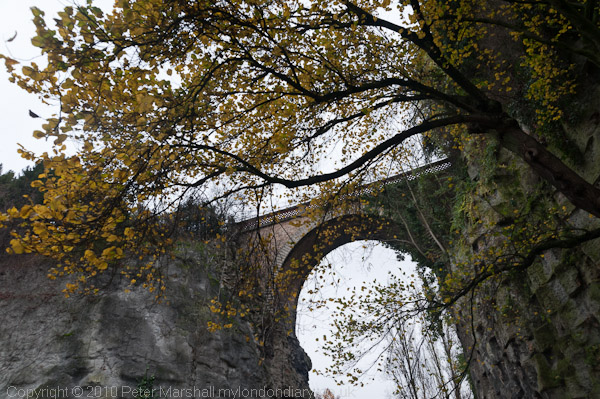
Buttes Chaumont
more pictures
We'd booked an evening Eurostar to give us another day in Paris, and had
decided to spend in walking aroun the north-east of the city, particularly
around the park at Buttes Chaumont. It could have been warmer, and there were
a few too many spots of rain but it was still enjoyable. I'd been hoping to
come across the sites of some of the pictures in my Photo
Paris book, as we'd walked many of these same streets then, but things
have changed quite a bit since 1988. There was only one that I could positively
identify, and if I hadn't already known that particular address I might not
have been sure. But it was still 'Ness Music' and the had the sign across
the top of the whole shop saying so, though the shop front was completely
new. But as you can see on >Re:PHOTO,
there was also that same drainpipe at the left and the odd patch on the pavement
edge. The colour of the name and board it was on appear to have changed slightly.
This being Paris, I can't believe it has been painted since I took the first
picture, so it just shows how inaccurate film colour can be!
We'd hoped to have a good lunch in the area and weren't disappointed, though
it slowed down our walking afterwards. It's perhaps a good place to start
another walk around Paris the next time we go, perhaps on a sunny summer afternoon.
And by that time the scaffolding may have disappeared where I've been thinking
about taking a picture in the Place de Ménilmontant for the last five
or so years.
more pictures
Paris Supplement: BnF and FIAP
Paris. Sunday 21 Nov 2010
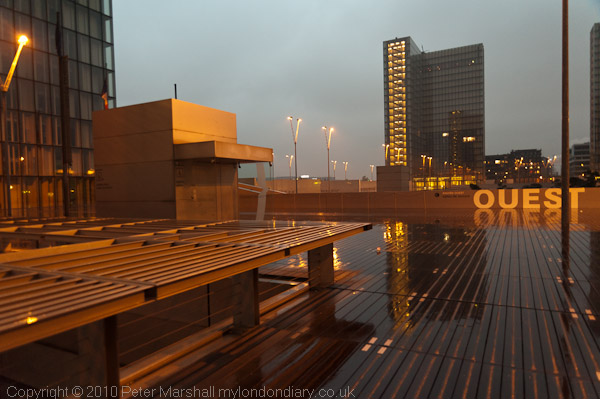 The
wet deck of the Bibliothèque nationale de France (BnF)
The
wet deck of the Bibliothèque nationale de France (BnF)
more pictures
We went to the Bibliothèque nationale de France (BnF) not to see Depardon's
France - I'd already seen much of his work from that - but the show he had
created by 14 younger French photographers, including some well-known guys
in their forties. From there we took a short detour around the area on our
way to another metro station and then made our way to a FIAP hostel in the
14e which had a show celebrating 40 Years of Women’s Lib in France.
You can read more about both shows on >Re:PHOTO.
After that we walked up to the rue Moufettard where we had a fairly cheap
but very nice and very French dinner.
more pictures
Paris Supplement: The Marais
Paris 3e & 4e. Sunday 21 Nov 2010
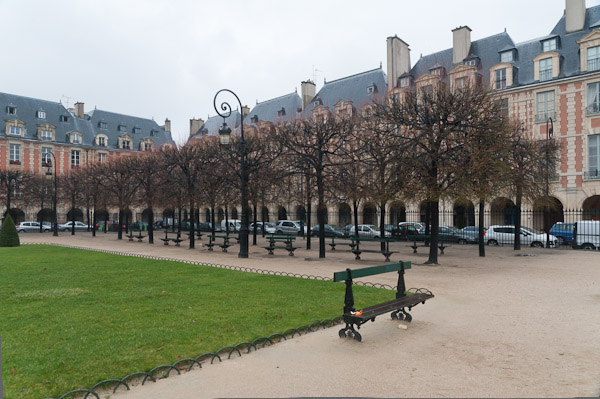
Orange peel left neatly on a bench in the Place des Vosges
more pictures
I didn't take any pictures on Sunday morning because as I walked into the
Maison Européenne de la Photographie, a truly delightful place on the
rue de Fourcy, enjoying free entry as one of the welcome but unadvertised
benefits of my union subscription, I read a large notice with a picture of
a camera crossed through. There was an illogicality that made me respect it.
But we had lunch afterwards in the Place des Vosges, above, though not sitting
on that seat (it was raining gently at the time) and no oranges, just a few
tasty delights bought at a nearby shop on the rue St Antoine.
You can read more about our wanderings around the few exhibitions in the
vicinity that open on Sunday afternoons on >Re:PHOTO
(3 posts starting here), and here are a few more pictures that I took of some
of them and on the streets of the 3e and 4e as we wandered about.
more pictures
Paris Supplement: Dinner at Chartier
rue du Fauborg Montmartre, Paris 9e. Saturday 20 Nov 2010
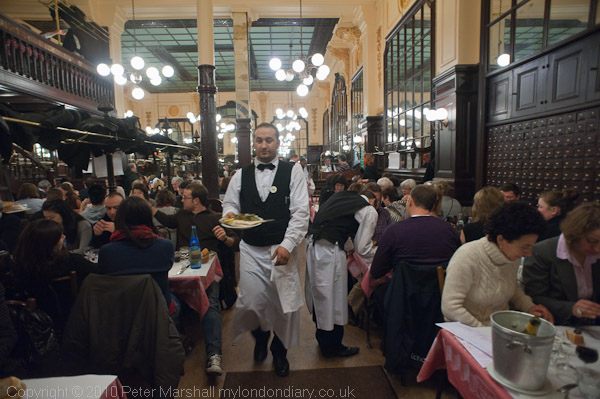
Chartier gets packed
more pictures
Chartier is now well known to tourists, though when we first went there it
was usually full of French people. The food isn't quite so good but is still
ok, typically French and relatively cheap, but the waiters not only now speak
English, but for the first time ours used a calculator to add up the bill.
We ate there with Linda's brother and his French wife who both work in Paris.
more pictures
Paris Supplement: Guided tour of the
Photo-OFF
'Beauborg', Paris. Saturday 20 Nov 2010
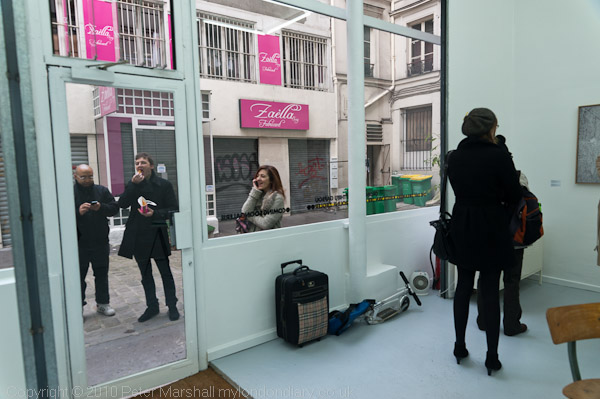
We met at the 'Coming Soon' gallery for a tour of the
Photo-OFF shows in the 'Beauborg' area
more pictures
This year for the first time there were guided tours around most of the 10
areas orf the Mois de la Photo-Off on Saturdays through November. We had a
choice of two areas the Saturday we were there and chose 'Beabourg', going
to eight shows and meeting the photographer or gallerist at all but one of
them. More about the shows we saw on Photo-Off
- A Guided Tour - 1 and Photo-Off
- A Guided Tour - 2 on >Re:PHOTO, but more pictures here.
more pictures
Paris Supplement: Street Photography in the 10e
Paris, Saturday 20 Nov 2010
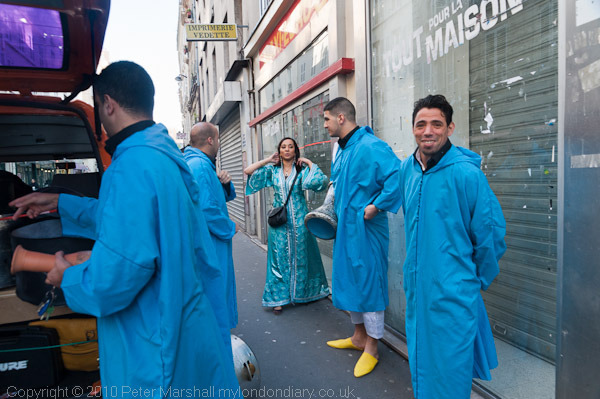
I found a few people to photograph on the street
more pictures
Stalingrad may have been renamed Volgograd, but there is still a Metro station
Stalingrad, just to the west of the Place de la Bataille de Stalingrad, one
of the key battles of the Second World War, and it was there we started our
walk on Saturday morning. As usual the Rotonde de la Villete was undergoing
renovation (will it ever be complete.) Linda decided we should walk a little
up beside the Bassin de la Villette, and we went as far as the footbridge
across it's centre before returning along the other side and they making our
way down along the Quaii de Jemappes. We crossed over onto the Quai de Valmy
and made our way to the lock, and after taking a few pictures around there,
started to search for the pictures in shop windows in the 'Street Photography
Now' exhibition, part of the Photo-OFF.
You can read more about that and the wedding pprocession we came across on
the rue de Lancry in Paris Street
Photography Now on >Re:PHOTO.
more pictures
Paris Supplement: Montmartre at
Night
Montmartre, Paris. Friday 19 & Sun 21 Nov 2010
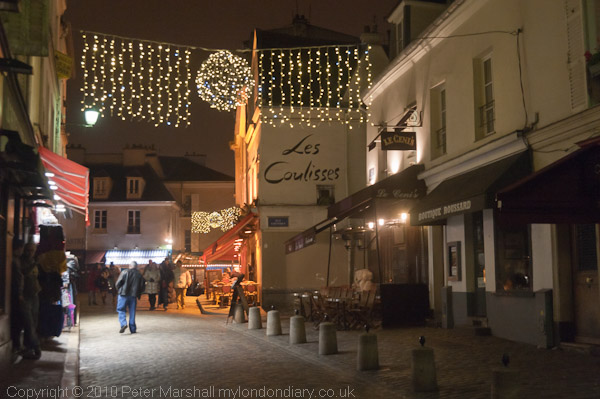
There were still a few other people walking the streets,
but it was pretty quiet
more pictures
After we had eaten it was quite late by the time we walked to the funicular
and rode up the hill to Sacre Coeur and started walking around Montmartre,
and the church was closing so we didn't go in. We walked along the rue Rustique,
and then back the few yarnds to the rue Norvins, before going down to the
vineyard and the Lapin Agile, then back and along rue Cortot. We saw a bus
coming and jumped on it and took a ride down to Place Pigalle, then walked
back to our hotel through some of the back streets.
We went up to Montmartre at night again on Sunday, rather later, when everything
was closed. This time we walked back down and along the rue d'Orsel back towards
the hotel.
more pictures
Paris Supplement: To Saint-Germain-des-Prés
Paris 1er and 6e. Friday 19 Nov 2010
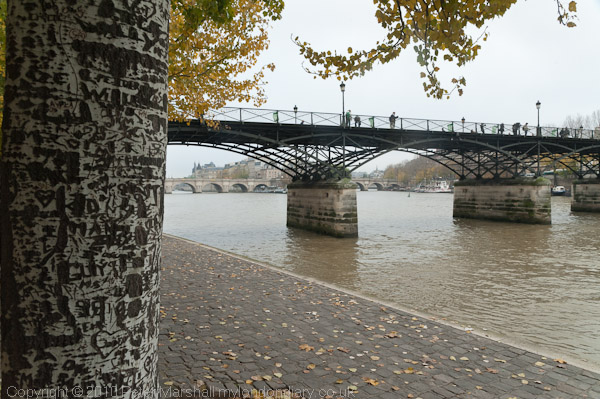
The Pont des Arts
more pictures
After the book launch I finished my tour of Paris Photo and left it - until
I come back, perhaps next year, but more probably in two years time when it
will again also the the Mois de la Photo in Paris. I was meeting Linda at
St Germain-des-Pres and it was easier to walk there - and I could go via a
few shows on the way, including a fine landscape exhibition. You can read
about the walk and the shows om >Re:PHOTO in More
Paris - French Landscapes, where I also write about some of the pictures
I took - and you can see more of them here. Afterwards we went for an early
evening walk taking in around 30 galleries in the Parcours
Saint-Germain-des-Prés.
more pictures
Paris Supplement: Lab East at Paris Photo
Paris Photo, Carrousel du Louvre, Paris. Friday 19 Nov 2010
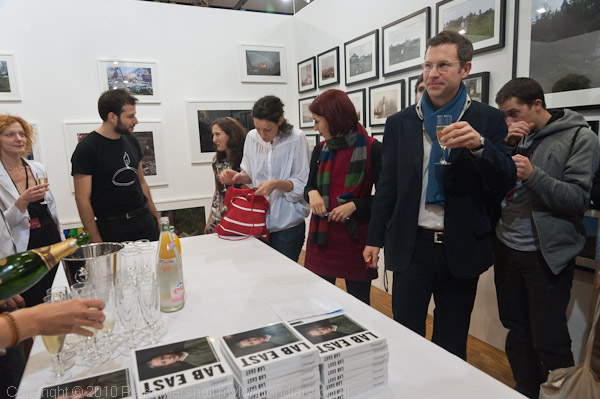
The book launch of Lab East - Editor and photographers
get ready for the signing
more pictures
Lab East is a fine book showing work by 30 young photographers
from Central and Eastern Europe, edited by Horst Kloever of Photeur.net and
produced with the support of Blurb Europe. I was invited to the book launch
by Teresa from Blurb and of course I took a few pictures. It was a bit of
a rush to get there on time - lunches in Paris tend to spread out rather,
and I arrived a little breathless, but just about on time. You can read more
about the book on >Re:PHOTO in the post Paris
Photo - Lab East. After the book launch I took my last look around the
few remaining stand of Paris Photo I had not already visited.
more pictures
Paris Supplement: Wandering in the 20e
Paris 20e. Friday 19 Nov 2010
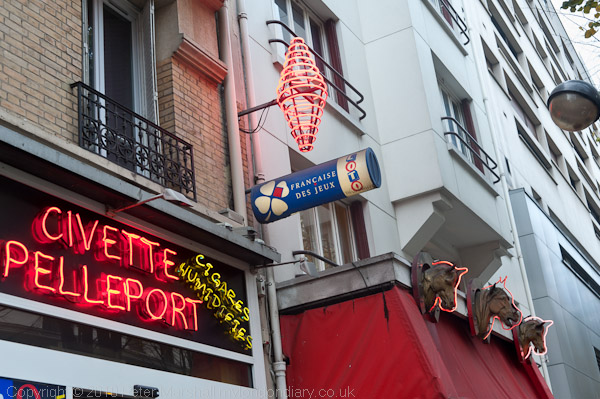
Pelleport
more pictures
You can read more about this area and our walk around it before a slightly
disappointing lunch on >Re:PHOTO in Wandering
in the 20e, but there are more pictures here on My London Diary.
more pictures
Paris Supplement: Jim & Millie's Party
Paris 5e. 18 Nov 2010
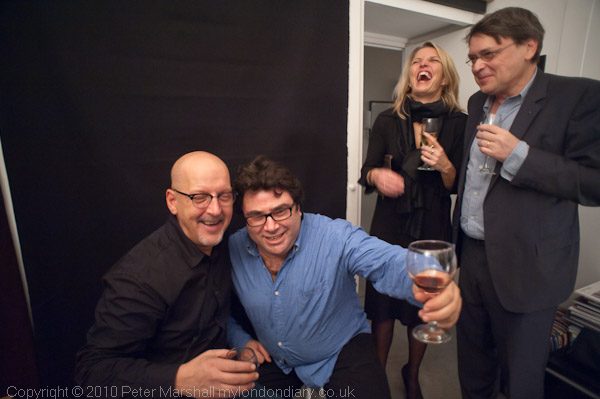
I photographed some of the people photographing themselves
at the party
more pictures
Lensculture is one of
the best photographic web sites around, and Jim Casper publishes some great
interviews and sets of work, and gets to know some of the most interesting
people in photography from around the world. Quite a few of them were in Paris
last week for Paris Photo, and quite a few were at a great party given by
Jim and Millie in their flat on the rue Saint Antoine, where the champagne
was flowing freely and, once I started taking pictures my shutter too.
As usual a little more about this in Paris
Party on >Re:PHOTO. I deliberately haven't captioned these
pictures, but some of you may recognise some of the people in them.
more pictures
Paris Supplement: Brian Griffin - The
Black Country
Paris 5e. 18 Nov 2010
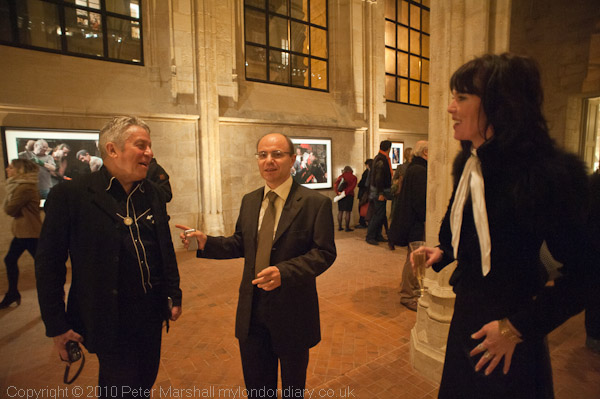
Brian Griffin at his show in the sacristy of the Collège
Des Bernadins, Paris.
more pictures
I went to the opening of Brian Griffin's show at the Collège Des Bernadins,
a splendidly restored old building. More about this in Brian
Griffin - The Black Country on >Re:PHOTO.
more pictures
Paris Supplement: In the 3eme
Paris. 18 Nov 2010
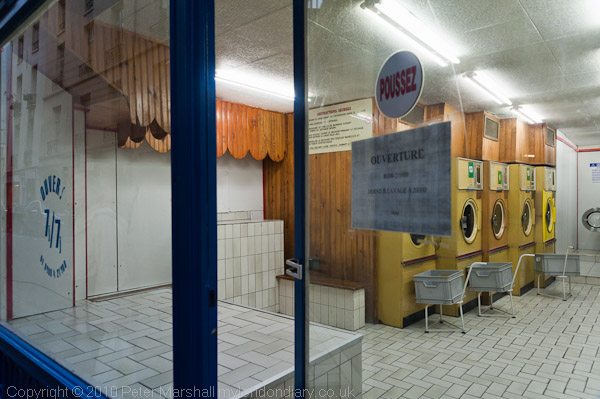 Launderette
in the 3eme
Launderette
in the 3eme
more pictures
Thursday afternoon we had a late lunch on the Boulevard des Filles du Calvaire
and then went to see the shortlisted work from the Prix Pictet before going
on to visit more photographic shows in the 3eme. There are more details in
Thursday Afternoon in Paris 3e
on >Re:PHOTO. And I took a few pictures as we walked around the area.
more pictures
Paris Supplement: 9e, 2e & Paris Photo
Paris. 18 Nov 2010
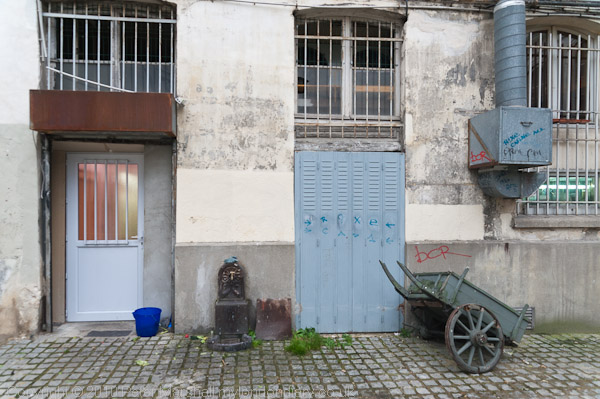
A recently re-opened courtyard off the rue Cadet
more pictures
Paris Photo doesn't open its doors until 11.30, so there was plenty of time
to have a wander on the way there, taking our time going south through the
9e and then along a few of the passages to the 2e and the Jardin du Palais
Royal.
I arrived just in time to stroll past the long queues waiting to get into the
show and be among the first there. It gets pretty tiring going round the show,
both mentally and physically, so I'd decided to put in a couple of hours there
and then go and have some lunch with Linda. You can read more about the morning,
and in particular about what I thought about Paris Photo, in
Paris
Photos Day 2 on
>Re:PHOTO
more pictures
Paris Supplement: Wednesday
Eurostar, Paris Photo & Paris. 17 Nov 2010
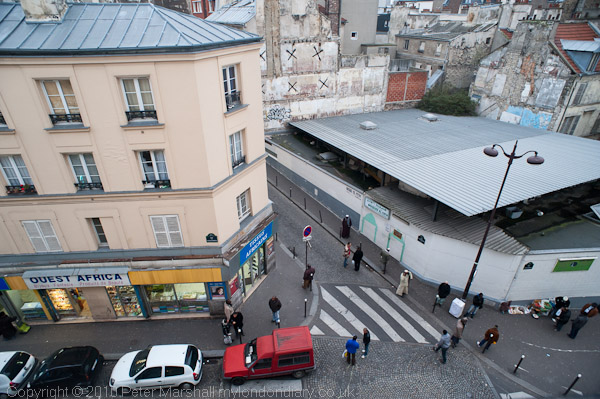
The view from our hotel room when we arrived on Wednesday
more pictures
We had a very smooth journey from London on Eurostar, and apart from reading
a book I amused myself taking a few pictures out of the window, but nothing
worth keeping. As we reached the tunnel I took a picture of Linda leaving
England, then another in the tunnel. Unfortunately by the time we came out
of the tunnel in France she had woken up.
We'd taken a slightly later train than I had wanted to keep costs down, and
I'd hoped to drop Linda and my case at our hotel and make a run for the Metro.
It took a little longer than expected as there was a small problem at our
hotel, and they had been forced to book us in to another hotel a quarter of
a mile to the north for the first night.
At Paris Photo it took a while to get my accreditation sorted out as things
were a little disorganised, but soon I was walking around the show. You can
read more about this in Paris Day One on my >Re:PHOTO blog.
I left Paris Photo at 8pm to meet Linda for a meal, and then we went for
a short walk around central Paris in the dark before taking the Metro back
to our hotel.
more pictures
============ End of Paris Supplement ======================
National Anti-fur March
Belgrave Square to Brompton Road, London. Sat 13 Nov 2010 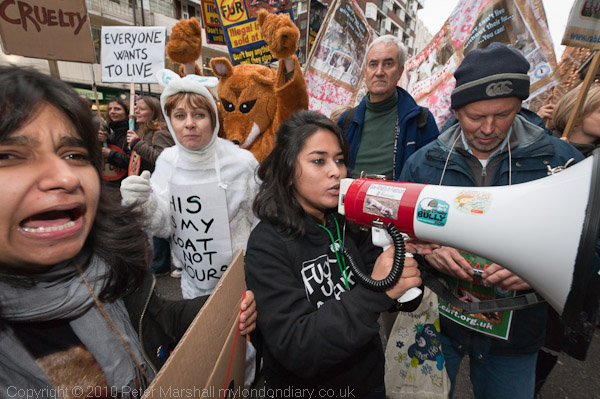
This could be the last year they need to protest outside Harrods as the new
owners may ban fur
more pictures
Several hundred people took part in a National Anti-Fur March past
upmarket fashion shops on a busy Saturday afternoon in Kensington and Chelsea
demanding that they end the cruel trade in animal fur. Many of the marchers
carried posters showing images of the horrific treatment of animals in fur
farms, and handed out leaflets with similar images. It was a more varied crowd
than on most demonstrations, including a number of people who would have looked
quite at home in the high-fashion shops they were protesting about, as well
as many in more ordinary dress and some from our wilder looking subcultures.
They were united in one thing, their opposition to animal cruelty.
As we were told at the start of the march in Belgrave Square, it was actions
such as this that had led to fur farming being made illegal in the UK in 2001.
And although it was still legal to sell products containing animal fur in
the UK, pressure from groups including the Coalition to Abolish the Fur
Trade (CAFT), the organisers of this march, had played an important role
in persuading many shops to stop dealing in fur products.
The march passed several shops that had been persuaded by the campaigns to
stop selling fur, including the largest shop on Sloane St, department store
Harvey Nicholls, and late this year, Escada.
However there are still some of the biggest names in fashion who sell fur
products, including Armani, Gucci, Fendi, Joseph, Prada, Versace, Gianfranco
Ferre, Dolce and Gabbana, Christian Dior, Roberto Cavalli, Nicole Farhi
in Sloane St, and in Brompton Road, Burberry and Harrods,
the only department store in the UK which still sells fur on the first part
of the march.
As the march went past each of these shops, the protesters named them and
chanted "Shame on You", and there was a lot of pointing
and shouting, but there was no attempt to attack them in any way, and the
strong force of police which was walking along with the march had little or
nothing to do, other than control traffic.
As they marched there were loud chants of "Fur Trade, Death Trade"
and "Fur on your back, Blood on your hands" and a couple
of women showed heavily blooded hands to illustrate this.
Outside Harrods the march stopped for a minute of silence in memory of the
millions of animals that have been cruelly killed to produce the fur products
sold there over the years, and there was a short speech. CAFT hope that this
will be the last year that the march will stop at Harrods, as they have had
talks with the new owners, Qatar Holding - essentially the Qatari Royal Family
- and expect them to end selling fur when they take over the commercial policy
of the store in January 2001.
As the march left Harrods there was a brief spontaneous sit-down on the road.
After a couple of minutes, the march organisers suggested that people might
like to get up and get on with the protest, as there were many more fur shops
they would like to visit in South Kensington and on the Kings Road in Chelsea,
which had not previously been included in the demonstrations, and everyone
got up and continued.
Possibly some of these further shops will be among those that now claims
to be ethically trading in fur goods by only selling 'vintage fur'. At the
short rally before the march we were told about a new campaign aimed at this
trade, and at so called "vintage" fashion chain, Beyond Retro,
which has shops in London, Brighton and in Sweden selling fur and where there
are now regular demonstrations. Of course today's new fur is tomorrow's vintage
and the existence of a trade in vintage fur encourages the continuance of
the fur farms (and all fur farms are cruel; producing fur without cruelty
is uneconomic) and is of course trading on past cruelty. But more seriously,
there isn't enough vintage fur to support the trade, and there is said to
be strong evidence that some fur passed off as vintage actually comes straight
from the fur farms, and any age it has is artificial.
A little further down the road they stopped again for a rather lengthy and
very noisy protest outside Armani. As this finished I decided it was time
for me to leave them.
more pictures
RIP Jimmy Mubenga - Killed at Heathrow
Home Office, Marsham St, London. Fri 12 November 2010
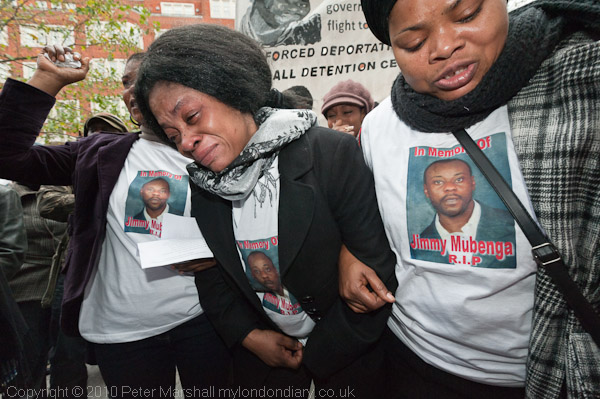
Jimmy Mubenga's widow in tears supported by family
more pictures
One month after Jimmy Mubenga died during an attempt to forcibly deport him
on a British Airways flight from Heathrow to Angola while being brutally restrained
by G4S security guards, members of his family, the Angolan community in the
UK and others marched from the Angolan Embassy to the Home Office calling
for a full inquiry into the issue of forcible deportation.
Jimmy Mubenga came to the UK in 1994, forced to leave Angola after the regime
had killed his wife's father and threatened him and his family because of
his activities as a student leader. His wife, Makenda Kambana, had fled a
few months earlier with their young son, and after a long legal battle the
family were granted exceptional leave to remain and they made a new life in
London where he worked for 16 years as a fork lift truck driver, and they
had four more children.
In 2006 he got involved in a fight in a nightclub and was sentenced to two
years prison. Following that, despite the fact that he was still likely be
killed if he returned to Angola, the UK authorities determined to deport him,
and in late August his final application for judicial review was refused.
A few weeks later he was taken by immigration officials to a detention centre
and on 12 October was taken to Heathrow and put on a BA flight to Angola by
three security guards employed by the private security contractor to the UK
Borders Agency, G4S.
Passengers on the flight witnessed him being forcibly restrained, while he
continually shouted "They are going to kill me" and then that he
could not breathe. Finally everything went quiet, an ambulance was called,
and after an unsuccessful attempt by the paramedics to revive him he was taken
to hospital and pronounced dead, apparently from asphyxiation.
It was not until six days later that the three security guards were arrested
and questioned by police; they were not charged but were released on police
bail while further inquiries are made.
This morning around 150 people, including his family members, others from
the Angolan community here, representatives of campaigning organisations including
No Borders, London No Borders, Corporate Watch, Inquest, Free Movement,
Medical Justice and the National Coalition of Anti Deportation Campaigns
as well as individuals wishing to show their solidarity, met at the Angolan
Embassy and marched through central London to the Home Office.
There they held a short rally, with speakers including Jeremy Corbyn,
MP, a member of the Mubenga family, Adalberto Miranda of the Union
of Angolans in the UK, Deborah Coles of Inquest, Emma Ginn
from Medical Justice and others, before the Mubenga family, together with
Jeremy Corbyn went to the door to hand in a letter for Home Secretary Theresa
May.
The letter, signed by Debora Coles, Emma Ginn, Adalberto Miranda, Jermy Corbyn,
David Lammy MP and Dr Richard Stone OBE (one of the panel on the Stephen Lawrence
Inquiry) asked that because of the disturbing circumstances around Mubenga's
death and the grief and distress that this has caused to his wife and family
that they quickly be granted indefinite leave to remain. It will also ensure
that they are able to take part in the inquiries.
It continued: "We appreciate that a police investigation and other inquiries
are ongoing and we have no wish to prejudge these inquiries. However the death
of Mr Mubenga raises a number of issues of wider concern that warrant urgent
public scrutiny in order to ensure further deaths and injuries are prevented."
They ask that "the Home Affairs Select Committee conduct an inquiry
around the issue of deportations and what constitutes proportional force."
This should include the use of private companies and the training these provide
for their staff, the methods of control and restraint approved by the UK Borders
Agency and its contractors and the current process for investigating complaints
that arise from forcible deportations.
It was an emotionally charged event, with Makenda Kambana and several other
of the family members breaking down in tears during the speeches and there
were angry scenes when the official who came out to meet them, David Cheesman,
said he could not let anyone in to the building to deliver the letter in person
for security reasons. But the family had made it clear that they wanted their
to be no disorder, and their wishes were respected. Eventually the letter
was handed to Cheesman and he promised to ensure that the Home Secretary received
it personally.
Among those who marched and spoke was Ayodeji Omotade. In March 2008 he was
appalled at the brutal treatment by four security guards (while two police
stood watching) of asylum seeker Augustine Eme, being forcibly returned to
Nigeria on a BA flight to Nigeria from Heathrow. Mr Eme was being held shackled
and handcuffed, screaming on the floor.
Omotade, a passenger on the plane. protested to them over the way they were
mistreating him.He was dragged off the flight by 20 Metropolitan police officers,
assaulted, arrested, held for nine hours and his money was seized and kept
for several months. BA banned him from all their flights, refused to refund
his ticket money and when they returned his luggage - containing clothes and
wedding rings for his family in Nigeria - a week later, it was damaged. BA
then pressed charges against him of threatening, abusive, insulting and disorderly
conduct.
The case took 14 months to come to court; Mr Omotade was refused legal aid
and his defence cost him thousands of pounds. The Nigerian High Commission
had at first promised support but then failed to do so. BA refused to supply
the passenger list so that witnesses could be found.
When the case finally came to court the testimonies of the nine witnesses
provided by BA - their own staff, police, G4 security staff and immigration
officers - contradicted each other. It became clear that, in Mr Omotade's
words "British Airways, the Metropolitan Police, Immigration security
officers and the Crown Prosecution Service (had) constructed a false and malicious
case against me." Mr Omotade's account was clear and compelling
and the magistrate found him not guilty. He is now demanding an apology and
full compensation for the brutal treatment he received - for being a 'good
neighbour' and standing up for someone in distress - and for his financial
losses, as well as those of his family in Nigeria.
Forced deportations are just one aspect of a rise in racist attitudes by
the UK government, spurred on by a right wing press that attacks the right
to asylum and mirrored by the growth of the BNP. As Jeremy Corbyn said, it
is all part of an "atmosphere (that) makes people think they
should walk by on the other side as grotesque brutalities are committed."
Thankfully there are still a few people brave enough not to do so - like Mr
Omotade.
Mr Mubenga is one of fifteen who have died at the hands of police and immigration
officials across Europe since 1991 - Joy Gardener in 1993 was the last in
the UK before him. Others have been made so desperate that they have committed
suicide rather than be deported, and still more have been returned and either
have been killed or simply disappeared.
more pictures
NUS/UCU March - Fees Increase & Cuts
Westminster, London. Wed 10 November 2010
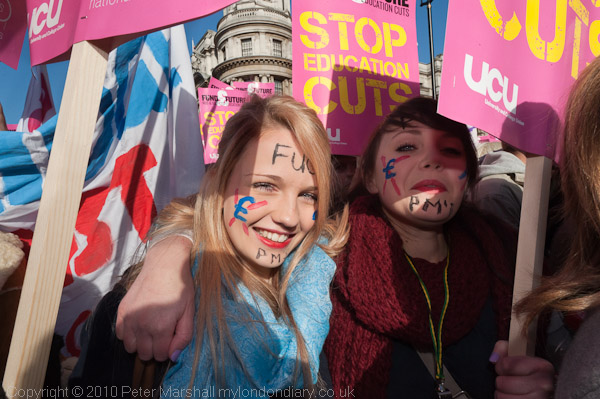
Despite the initials on their faces I didn't take it
personally
more pictures
Around 50,000 students marched peacefully through London in a lively protest
against planned fees increases and cuts. A couple of hundred then walked into
the London Conservative HQ. Later there were fierce fights with the police
after the students had been attacked fairly randomly and brutally to remove
them, and the glass windows fronting the building were smashed.
As I arrived students were flooding into Whitehall and the surrounding streets
from all directions, and it was clearly going to be a very large event (later
the figure was put at 52,000) and because of the crush the march made an early
start past Downing St and the Houses of Parliament and on down Millbank to
the Tate Gallery where there was to be a rally. Over two hours later, the
end of the march had still not reached Parliament Square, and the road in
Parliament Square was partly blocked by a large crowd of students. A little
later a samba band arrived to entertain them, and as I was leaving around
4pm, a group lifted the temporary fences around Parliament Square and began
to dance there.
There were many banners and placards, many with angry messages about the
broken promises of the Lib Dems who before the election had been resolutely
against fees but now their leader and many others in the Lib-Con coalition
have given the proposals to allow them to rise to £9000 per year their
support.
It was a lively march and many students had made an effort with banners,
placards, painted faces and in various forms of fancy dress. One group came
with a very large cannon, while another carried a semi-naked man on a large
plank; there were several coffins and what I think was a giant carrot, though
its meaning was lost on me.
The anger felt at the cuts showed in many of the placards, although there
was also a great deal of humour. There was also considerable disillusion,
particularly over the about-face by the Liberal Democrats, abandoning the
NUS pledge they had signed and their manifesto committment to abolish fees.
Clearly all felt this was the biggest challenge to higher education at least
since fees were first introduced. But the great majority of the protesters
were wanting to make their views clear without any violence, although there
were a couple of very minor incidents with fireworks or flares in Parliament
Square, as well as the inevitable sit-downs in the road, although the only
effect of these was to slow down the march..
But a small group of protesters had other ideas, and on reaching the Millbank
Tower more or less at the front of the march around 2pm they walked into the
Conservative Party HQ there, which had been left virtually undefended by police,
and occupied it. Shortly after more police arrived and carried out a brutal
eviction attempt - in which several of the press who had by then also arrived
were also batoned and punched, and things got very much more viscious. Some
protestors smashed the large plate glass frontage to allow others in. A small
group gained access to the roof and let down banners. Most of those present
- perhaps a couple of thousand simply stood around in the courtyard, where
a couple of fires wiere lit and many placards burnt. There was one seriously
dangerous moment (which I didn't see) when a stupid idiot threw an empty fire
extinguisher from the roof; fortunately no one was injured, but it could have
killed a police officer or a protester, and the whole crowd began a chant
against him.
Student leaders, including NUS President Aaron Porter condemned their actions,
and the march stewards tried to direct others away from joining the crowd
around the Tory HQ. Actions such as this do ensure that the event is headline
news - and without it there would probably been only brief mentions in mainstream
media - but they also allow the media and politicians to shift the debate
away from the issues of education cuts and fees increases. For those of us
who had been there, some of the commentary in the news and reactions of politicians
seemed frankly absurd.
I heard about it outside the Houses of Parliament because one of the marchers
got a tweet from his mother who was watching it on TV, and a few minute later
another journalist told me that the protesters outside the building had lit
fires in the courtyard, burning placards and singing "Build a bonfire,
build a bonfire, put the Tories on the top. Put the Lib-Dems in the middle
and burn the f----ing lot."
Apparently the workers in the Tory HQ, along with those in the other government
offices in the building were mainly evacuated rapidly from the building as
the protesters gained access, although a few elected to stay. And the cafe
on the corner of the building was still carrying on normally as I arrived
much later. The protesters on the roof issued a press statement saying that
their action was an expression of solidarity with public sector workers and
the poor, disabled and elderly who would be harmed by government cuts and
was a call for direct action to oppose the destruction of public services
and state education.
When I arrived later, more riot police were arriving to stand in front of
the now broken window and protect the offices. A couple of yards from them
was a crowd who were mostly simply standing and watching, with a few occasionally
shouting at the police and arguing with them. Occasionally various objects
were hurled from further back in the crowd towards the police who parried
them with their riot shields; fortunately they were largely harmless - light
sticks from placards, screwed up placards, plastic bottles - just as well
as many fell short and landed on photographers and crowd rather than their
intended target. I was hit by a few objects and sprayed several times by fire
extinguishers - both soda acid and dry powder - and again the police were
better protected. At one point a woman's shoe came through the air and landed
at the feet of the police, followed a few moments later by a furious woman
with one stockinged foot who came to collect it after one of her 'friends'
had thrown it.
In general the police response to the whole demonstration by now seemed sensibly
low key, and while I was there they largely simply stood to protect the property
and prevent any further entry.
Once or twice a few police made charges into the crowd - once to pick up
a glass bottle from the ground and another time to chase one of the protesters
who made a hasty exit. But by now there were rather more press and other photographers
than active protesters, and there seemed little point in staying longer, and
I walked away to the nearest station for my train home.
The police appeared to be holding a small group of people inside the building,
and there were others on the roof. Later I heard from Twitter that around
35 arrests had been made (later the police increased this figure to over 50).
There were also reports that earlier in the day a number of people had needed
hospital treatmentfor minor injuries including at least one police injured
by broken glass when the large window was smashed.
more pictures
UAF March Against Racism
Malet St to Millbank, London. Saturday 6 Nov 2010
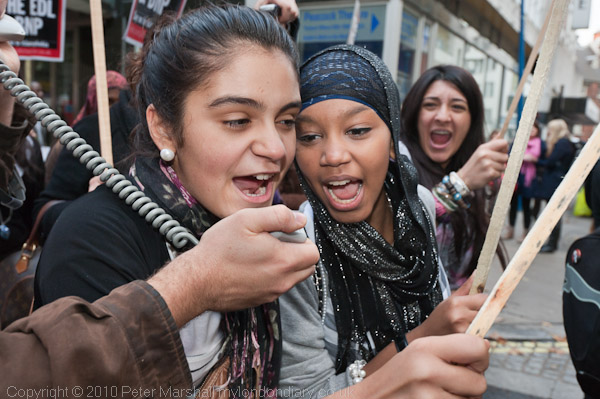
Chanting on the march
more pictures
Several thousand anti-racists held a rally and marched through the centre
of London to a carnival to show their opposition to the English Defence League
(EDL) and other racist and Islamophobic groups.
The protest, organised by UAF and Love Music Hate Racism, supported by the
TUC and Muslim Council of Britain have called a national march and carnival
gathered outside the University of London Union in Malet St, where a lorry
played music and there were then speeches by one of the UAF leaders, the Green
Party's Jean Lambert MEP, Bruce Kent, Emily Thornbury MP, Jean Lambert MEP,
TUC assistant general secretary Kay Carberry and others.
Speakers stressed the need to take action and oppose racism and Islamophobia
whoever was responsible for it. Among those in the audience were trade union
branches and trade councils from around the country with their banners, and
a group from the Muslim Defence League (MDL.) It was an audience that represented
the plurality of Britain today, all ages and ethnicities and there was a cheerful
and purposeful atmosphere with people enjoying the music as well as having
a serious intent.
It had a very different feel to the EDL events I've photographed. Everyone
was in a good mood and apart from one rather shy couple happy to be there
and to be photographed. A few were drinking coffee, but there was no alcohol
in view during the event. And although the speakers were sometimes forthright
in denouncing racism, there was none of the evident hate that I've felt at
right-wing events.
A Jewish woman speaking voiced the opposition felt by much if not all of
the Jewish community in the country to the EDL and similar groups. But despite
this, the UAF to their shame failed to have any effective presence at the
Israeli embassy last month to oppose the EDL when they came with a right-wing
Zionist Rabbi to express their support for Israel. There were only a handful
of protesters, mainly from the MDL and other left-wing groups.
Bruce Kent spoke of how Western racism against the Japanese had created a
mindset that enabled America to drop atomic bombs on the civilian populations
of Hiroshima and Nagasaki, who were seen as less human than us, and that a
similar anti-German feeling enabled us to commit atrocities against Germans,
just as the Aryan myths dehumanised Jews (and gays, Roma and others) leading
to the holocaust.
After the speeches the march set off through Holborn to the Strand and Trafalgar
Square and then down Whitehall and past the Houses of Parliament to some speeches
and live music in a carnival atmosphere on Millbank. Before the music started,
Weyman Bennett of the UAF and Martin Smith of Love Music Hate Racism gave
short speeches, but the biggest applause came for George Galloway. Unfortunately
I had to leave before the end and didn't hear much of the music or the last
set of speeches, which were expected to include Tony Benn.
more pictures
Blurb Celebrates London Pop-Up
Eastcastle St, London. 3 Nov 2010
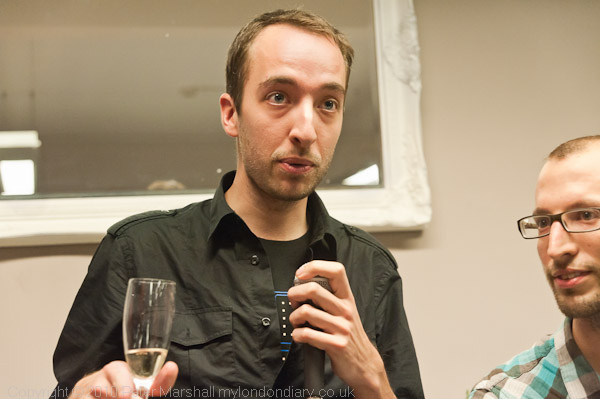
'WassinkLundgren' were winners in the portfolio category
Blurb opened their London pop-up shop with a party which also celebrated
the winners of their 2010 'Photography Book Now' exhibition. >Re:PHOTO
has more about the event.
more pictures
top of page
All pictures on this section of the site are Copyright ©
Peter Marshall 2010; to buy prints or for permission to reproduce pictures
or to comment on this site, or for any other questions, contact
me.





 The
wet deck of the Bibliothèque nationale de France (BnF)
The
wet deck of the Bibliothèque nationale de France (BnF)
















